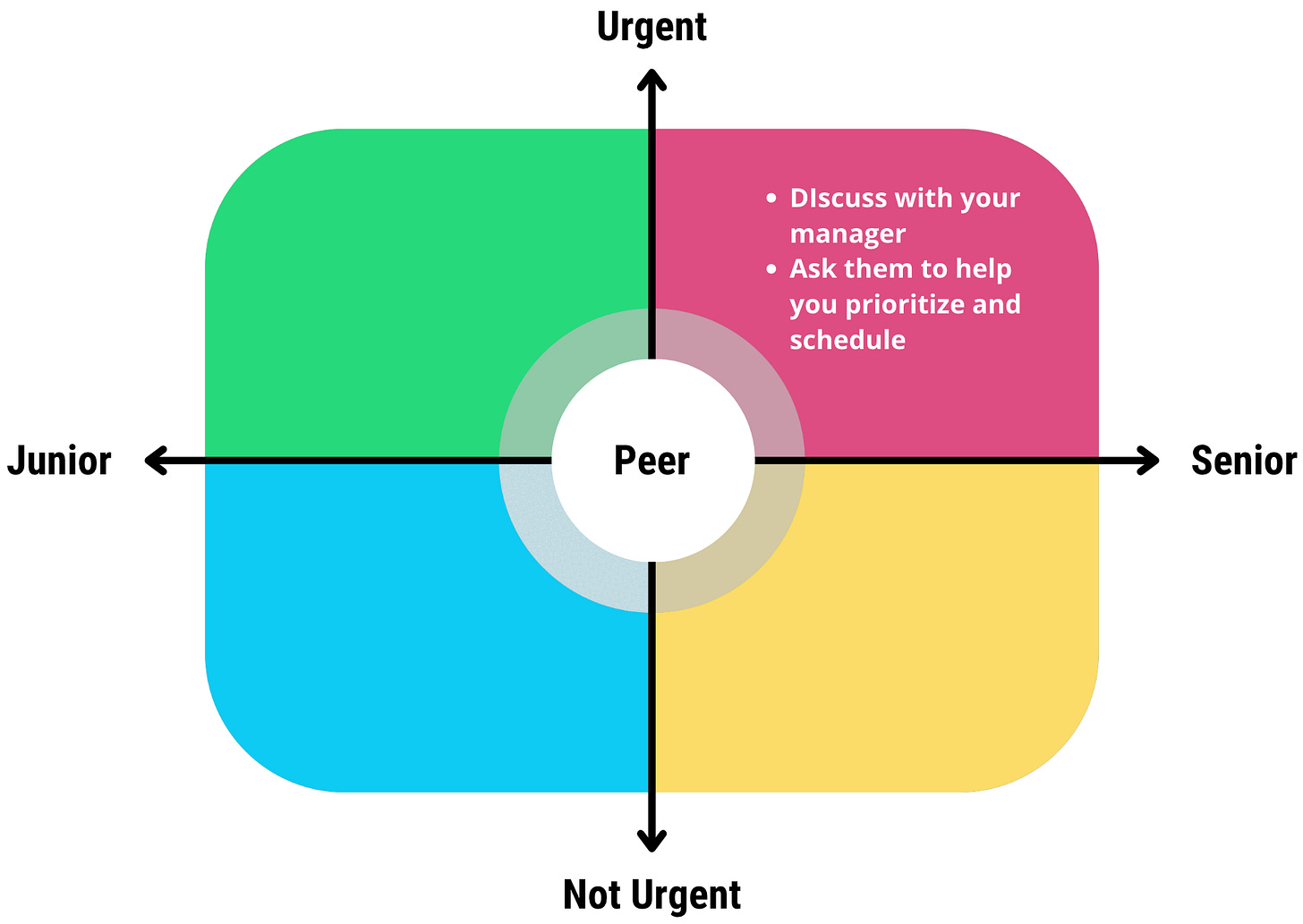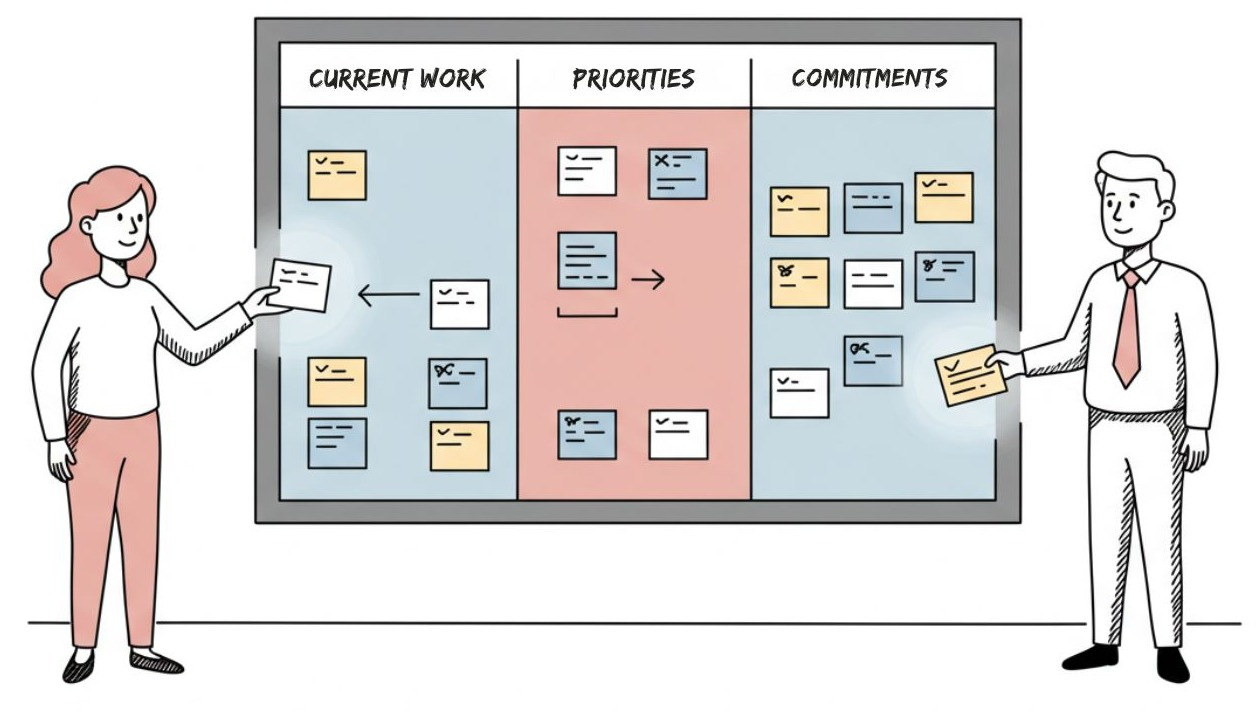How to Say NO to Someone at work?
A Framework to say "no" to your Manager, Seniors, Peers and Juniors at work.
Welcome to the 🔥 free edition 🔥 of Winning Strategy: a newsletter focused on enhancing product, process, team, and career performance. This newsletter shares insights gained from real-world experiences that I gathered working at Twitter, Amazon, and now as an Executive Product Coach at one of North America's largest banks. If you’d like to become a paid member, see the benefits here, and feel free to use this expense template to ask your manager.
"This is a priority."
When someone drops these four little words on you at work, saying "no" feels almost impossible. The weight of an entire organization's expectations seems to crush you.
Who are you to say "no" to a priority?
Never mind if you're already juggling three other "priorities."
Never mind if you're working at capacity.
Never mind if saying "yes" means sacrificing your work-life balance or the quality of your other deliverables.
I've spent the last decade watching smart, capable professionals crash under the weight of too many "priorities." Not because they couldn't handle the work but because they never mastered the art of saying "no."
Early in my career, I was the classic yes-person.
Project deadline impossible? "Yes, I'll make it work."
Third urgent priority this week? "Yes, I'll somehow manage."
Another meeting during my focused work time? "Yes, I'll adjust."
I thought being agreeable made me a team player.
IT DIDN’T!
It made me a bottleneck.
It wasn't until I watched my most respected colleague confidently decline (strategically) an Executive's request during a meeting (in front of everyone) that I realized something:
The most valuable professionals DON’T say "yes" to everything. They know when and how to say “no”
Over time, I learned that saying "no" is a skill, just like public speaking or coding. And like any skill, it requires different techniques for different situations.
Saying "no" to your CEO requires a different approach than saying "no" to a Peer.
And saying "no" to a junior team member?
That's another thing entirely.
Today, I'm sharing a simple framework I wish I had 10 years ago.
I used this framework to evolve from a yes-person into a respected decision-maker.
All it takes is practice.
Let’s get started.
If you’re new, here’s what you missed in the last few weeks
Certified Scrum Master (CSM) - Brutally Honest Review Of the Most Popular Certification
How Agile Metrics are Getting Misused - And How Can You Fix It?
🎁 New Video Announcement
I have just released a new video on Splitting User Stories. A Full Step-by-Step Walkthrough. Check it out below.
Prerequisites for saying “no” (or “yes”)
Before you can confidently decline (or accept) a request, you need to be clear about three critical factors. These are the foundations; without them, even the best approach to saying "no" will fall flat.
1. Know Your Current Commitments
You can’t consider a new request unless you know your current workload.
What are your priorities?
How is your calendar organized?
What’s already on your plate, and what is your capacity?
If you don’t know the answers, saying "no" will feel like guesswork, which could be dangerous.
2. Your Relationship With the Requester
Who’s asking you for help?
Who is the requester?
Are they your junior, your peer, or your senior?
How you say "no" will depend on their level of seniority and your working relationship.
A "no" to an Executive looks very different from a "no" to a colleague on your team.
3. Time Sensitivity of the Request
Not all requests are equal.
Is this request urgent, or can it wait?
Understanding the time sensitivity of the ask will help you decide whether to decline outright or negotiate a later timeline.
These prerequisites are basic, but I've found that most uncomfortable "yes" responses happen when professionals lack clarity in one of these areas.
So, take a moment to establish these fundamentals before you respond to any request.
It will make saying a strategic "no" much easier and more effective.
No/Yes Decision Matrix
The No/Yes Decision Matrix is a simple framework I developed to help me decide “what” to do when someone makes a request.
The matrix you see above organizes your response based on two key factors we just discussed: the requester's seniority level (junior, peer, or senior) and the urgency of the request.
This framework helps you determine what action to take based on these prerequisites.
Once you know what you should do, figuring out the “how to communicate it” becomes much more manageable.
Here’s a brief synopsis of each of the 4 quadrants:
Upper Right (Urgent + Senior): Discuss with your manager and ask them to help you prioritize and schedule the request
Lower Right (Not Urgent + Senior): Schedule when your capacity allows, and ask the Executive requester to confirm if the proposed timeline works for them
Upper Left (Urgent + Junior): Ask them to schedule in your calendar at the available spots
Lower Left (Not Urgent + Junior): Say "no" politely or suggest meeting over lunch or coffee
For requests from “Peers” (those at the same level as you), your response could fall into any of the 4 quadrants depending on:
their timeline
your capacity
the project's priority
your current commitments
This matrix IS NOT rigid; it's a starting point.
Use it to make quick decisions before crafting your response.
Your relationship with the requester and the time-sensitivity of their ask creates a unique context for each situation. By quickly plotting the request on this matrix, you'll have immediate clarity on the appropriate response.
But let me be clear!
You are not trying to “avoid” work.
You are trying to manage expectations and your capacity professionally and respectfully.
Let’s explore each quadrant in more detail.
#1: Upper Right (Urgent + Senior)
This is perhaps the most challenging quadrant in the matrix.
When a senior stakeholder comes to you with an urgent request, the pressure to simply say "yes" can be huge.
But remember, saying "yes" to something means saying "no" to something else, even if by default.
Your senior stakeholder needs something urgently, but you're already at capacity.
This isn't the time for a direct "no."
It's time for “strategic” escalation.
Here's how I’d navigate this delicate situation:
1. First, acknowledge the importance of their request.
"I understand this is a priority and needs immediate attention."
2. Then, be transparent about your current commitments.
This is why knowing your priorities is essential.
"Currently, I'm focused on [specific priority], which is due by [date]."
3. Next, involve your manager or supervisor.
Don't try to handle this alone. Your manager needs to:
know about competing priorities
help assess true urgency
make informed trade-off decisions
This is the key difference in handling senior requests: you need alignment from your direct leader.
Say this to the “senior” requester:
"I'd like to discuss this with [manager's name] to ensure we're aligned on priorities. Could we briefly meet with her to determine the best way to integrate this into my current workflow?"
If the “senior” requester is not available to meet with your manager, say this to your manager:
"I've received this urgent request from [Senior Leader]. Given our current priorities [list them], I'd like your guidance on how to proceed."
Ask your manager to help you prioritize. You need clarity on what gives:
which current project can be delayed?
can another team member take something off your plate?
should you adjust other deadlines?
The key is to show you're not saying "no." You're asking for help to say "yes" effectively.
Sometimes, saying "no" means saying "yes, with help."
#2: Lower Right (Not Urgent + Senior)
This is a “diplomatic” quadrant.
When a senior stakeholder or executive approaches you with a request that is NOT time-sensitive, you have more flexibility.
But you still need to handle the situation with care and professionalism.
The key here is to schedule the work when your capacity allows while giving the senior stakeholder the final say on timing.
1. Start by acknowledging their request and showing interest.
"Thank you for thinking of me for this. It sounds like an interesting/important initiative."
2. Be transparent about your current workload and propose a specific timeframe.
"I'm currently focused on [current priorities]. I could dedicate time to this starting [this date] when my current commitments are completed."
3. Then, put the decision back in their hands.
Let them decide. Give them the final say:
present your proposed timeline
let them choose to wait or escalate
Say,
"I can give this my full attention in [timeframe]. Given my current priorities, this would ensure the quality you expect. Would that timeline work for you?"
4. If needed, suggest alternatives that might better serve their needs.
"Alternatively, if you need this sooner, [team member] might have bandwidth, or I could help identify someone else with the right skills."
This approach accomplishes several things at once:
It honors the senior stakeholder's position
It shows your professionalism
It sets clear expectations about when the work will be done
It gives them control over the final decision
Senior stakeholders respect good prioritization.
By showing that you're managing your workload thoughtfully rather than saying "yes" to everything, you actually increase your professional credibility.
Here, "no" is a "yes, when."
#3: Upper Left (Urgent + Junior)
This is the “boundary-setting” quadrant.
When a junior colleague approaches you with an urgent request, you have an opportunity to mentor while also maintaining your boundaries.
The strategy here is to acknowledge their urgency while having them schedule time in your calendar. This teaches them how to respect others' time while meeting their needs.
Here’s how to approach this situation:
1. Begin by validating their concern.
"I understand this feels urgent to you, and I want to help."
2. Then, explain your current commitments briefly.
"I'm in the middle of [current priority] right now, which requires my full attention."
3. Guide them to schedule a specific time with you.
"Could you please schedule 30 minutes in my calendar for later today or tomorrow (or next week)? You'll see my available slots. That way, I can give your issue my full attention."
Part of your role with junior colleagues is to model professional behaviour.
By having them schedule time rather than dropping everything for them, you're teaching valuable workplace skills while still being supportive.
Sometimes, saying "schedule it" is better than saying "no."
#4: Lower Left (Not Urgent + Junior)
This is the “mentoring” quadrant.
When the request comes from someone junior to you and is not urgent, this is the easiest quadrant to navigate.
You have the opportunity to provide guidance without immediate pressure, while setting boundaries to protect your time.
Here’s how to handle it:
1. Acknowledge the Request
Show that you value their effort and initiative in reaching out.
“Thanks for bringing this to me.”
"While I can't take this on, let's grab coffee and discuss some alternatives."
These informal environments often lead to more natural conversations, where junior colleagues feel comfortable asking questions they might hesitate to raise in formal settings.
Plus, these interactions build relationships without sacrificing your productivity during core working hours.
2. When You Meet for Coffee, Assess Its Importance
Since the request IS NOT urgent, evaluate whether it requires your direct involvement or if it’s something they can handle independently.
“Can you tell me more about this? What’s the goal, and how can I best support you?”
3. Set Boundaries
If the task doesn’t require your immediate attention, politely defer it or redirect them to handle it on their own.
“This sounds like something you can take the lead on. Let’s check back at [specific time] to see how it’s going.”
Or.
4. Offer Guidance Instead of Ownership
Use this as an opportunity to mentor them.
“Here’s how I’d approach this: [specific advice]. Try this out, and let me know if you hit any roadblocks.”
5. Be Polite but Firm
If you need to say “no” directly, do it in a way that maintains the relationship and encourages independence.
“I’m not able to take this on right now, but I’m confident you can make progress with the steps we discussed.”
Saying "no" to a junior colleague can actually be a form of empowerment when you provide them with alternatives that help them grow their own capabilities.
Sometimes, a "no" is more valuable than a "yes."
What if the “requester” is your peer?
This is where the matrix gets interesting.
Peer relationships are complex because they exist in a state of mutual influence without hierarchical clarity. Their requests can land in any quadrant, depending on multiple factors.
Here's how to navigate peer requests:
1. Assess the impact of the situation. Before responding, consider:
true urgency vs. perceived urgency
your current capacity and commitments
project impact and stakeholders
organizational priorities
relationship dynamics
Then Map It:
2. Urgent + High Impact
treat it like the Upper Right quadrant
discuss with your manager
seek prioritization help
find collaborative solutions
3. Urgent + Low Impact
use the Upper Left approach
request proper scheduling
help define true urgency
set clear expectations
4. Not Urgent + High Impact
apply the Lower Right strategy
schedule when capacity allows
let them participate in timing
keep communication open
5. Non Urgent + Low Impact
follow the Lower Left method
meet informally
find alternative solutions
maintain the relationship
Strong peer relationships are built on clear communication and mutual respect.
Not on saying yes to everything.
What if the “requester” is your Manager?
Traditional yes/no dynamics don’t work when your manager is the requester.
What worked for me was creating a system that makes my capacity visible. The Solution was a simple shared Kanban board that:
showed all my current work
made my capacity visible
tracked my priorities
documented my commitments
This board was shared with my manager. It is still the foundation for all our prioritization discussions.
When new requests come in, focus on prioritization, not rejection. Move the conversation from "yes/no" to "where does this fit?"
I don't say “no” when my manager brings a new request.
I direct their attention to our Kanban board and ask:
“Given these current priorities, where would you like this new task to fit? What should I deprioritize to accommodate this?'"
This approach accomplishes several valuable things:
it eliminates the need to say "no" to my manager directly
it keeps the responsibility for prioritization decisions where it belongs, i.e. with my manager
It creates a visual, shared understanding of my workload and capacity
Sometimes, the best way to say "no" is to show why "yes" requires a trade-off.
The Journey Forward
Mastering the art of saying "no" professionally is a lifelong skill that will serve you at every career stage.
Navigating requests at work, whether they come from juniors, peers, or managers, requires:
clear communication,
prioritization, and
the ability to set boundaries
You can handle requests effectively by customizing your approach to each situation.
Stay transparent about your capacity, use tools like Kanban boards or other systems to manage your workload, and engage in collective discussions when prioritization is needed.
By doing so, you will protect your own productivity and build trust and stronger relationships with those around you.
Learning to say “no” IS NOT about saying “no” to everything. It’s about saying “yes” to the right things.
Show your support
Every post on Winning Strategy takes 3 days of research and 1 full day of writing. You can show your support with small gestures.
Liked this post? Make sure to 💙 click the like button.
Feedback or addition? Make sure to 💬 comment.
Know someone who would find this helpful? Make sure to recommend it.
I strongly recommend that you download and use the Substack app. This will allow you to access our community chat, where you can get your questions answered and your doubts cleared promptly.
Research
https://williammeller.com/the-science-of-saying-no-at-work/
https://academia.stackexchange.com/questions/657/when-is-it-appropriate-to-decline-a-review-request
https://hbr.org/2015/12/how-to-say-no-to-taking-on-more-work
https://www.sunsama.com/blog/how-to-say-no-at-work
https://www.scienceofpeople.com/how-to-say-no/
https://insight.ieeeusa.org/articles/saying-no/
https://cerebral.com/care-resources/communicating-boundaries-at-work
https://hive.com/blog/how-to-turn-down-extra-work-politely/
https://womenrisingco.com/articles/10-tips-to-set-boundaries-with-your-manager/
https://www.gainyouredgecoaching.com/post/saying-no-isn-t-selfish-boundaries-as-self-care
https://hbr.org/2022/04/a-guide-to-setting-better-boundaries
https://itsyourcareer.blog/how-to-be-assertive-at-work-without-being-a-jerk/
Further Reading
Connect With Me
Winning Strategy provides insights from my experiences at Twitter, Amazon, and my current role as an Executive Product Coach at one of North America's largest banks.











